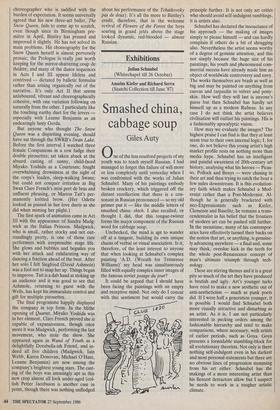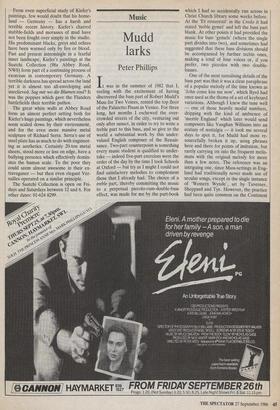Exhibitions
Julian Schnabel (Whitechapel till 26 October) AnseIm Kiefer and Richard Serra (Saatchi Collection till June '87)
Smashed china, cabbage soup
Giles Auty
0 ne of the less resolved projects of my youth was to teach myself Russian. I had managed to forget this failure of will more or less completely until yesterday when I was confronted with the works of Julian Schnabel. Many of his paintings embody broken crockery, which triggered off the distant recollection that there is a con- sonant in Russian pronounced — so my old primer put it — like the middle letters of smashed china: shtch. I also recalled, or thought I did, that this tongue-twister forms the major component of the Russian word for cabbage soup.
Unchecked, the mind is apt to wander off at a tangent, building its own unique chains of verbal or visual association. Is it, therefore, of the least interest to anyone that when looking at Schnabel's complex painting 'A.D. (Wreath for Tennessee Williams)' my head was simultaneously filled with equally complex inner images of the famous soviet potage du jour?
It could be argued that I should have been facing the paintings with an empty and receptive mind. Not only do I concur with this sentiment but would carry the principle further. It is not only art critics who should avoid self-indulgent ramblings, it is artists also.
Schnabel has declared the insouciance of his approach — the making of images simply to please himself — and can hardly complain if others do a bit of shrugging also. Nevertheless the artist seems worthy of a degree of genuine attention, and this not simply because the huge size of his paintings, his youth and phenomenal com- mercial success have already made him an object of worldwide controversy and envy. The works themselves are brash as well as big and may be painted on anything from canvas and tarpaulin to velvet and pony- skin. How well they will last is anyone's guess but then Schnabel has hardly set himself up as a modern Rubens. In any case I do not think the artist believes civilisation will outlast his paintings. His is a fashionably apocalyptic vision.
How may we evaluate the images? The highest praise I can find is that they at least seem true to their own internal logic; 1, for one, do not believe this young artist's high market profile rests on nothing more than media hype. Schnabel has an intelligent and painful awareness of 20th-century art history, analysing what his heroes — Picas- so, Pollock and Beuys — were chasing in their art and then trying to catch the boat a few miles downstream. It is this evolution- ary faith which makes Schnabel a Mod- ernist rather than a Post-Modernist. Al- though he is generally bracketed with neo-Expressionists such as Kiefer, Clemente and Baselitz, he remains a trans- cendentalist in his belief that the frontiers of modem art can be pushed still further. In the meantime, many of his contempor- aries have effectively turned their backs on the notion that art, or anything, is genuine- ly advancing anywhere — a final and, some may think, overdue kick in the teeth for the whole post-Renaissance concept of man's ultimate triumph through tech- nology.
These are stirring themes and it is a great pity so much of the art they have produced is brutish and ugly. Art's younger turks have tried to make a new aesthetic out of anti-aestheticism — much as punk poets did. If I were half a generation younger, it is possible I would find Schnabel both more visually attractive and disturbing as an artist. As it is, I am not particularly interested in pecking orders among the fashionable hierarchy and tend to make comparisons, where necessary, with artists of earlier periods, such as Goya. Goya presents a formidable stumbling-block for all evolutionary theorists. Not only is there nothing self-indulgent even in his darkest and most personal statements but there are no obvious lines of progression stemming from his art either. Schnabel has the makings of a more interesting artist than his fiercest detractors allow but I suspect he needs to work in a tougher artistic climate. From even superficial study of Kiefer's paintings, few would doubt that his home- land — Germany — has a harsh and terrible recent history. Kiefer's charred stubble-fields and morasses of mud have not been fought over simply in the studio. His predominant blacks, greys and ochres have been warmed only by fire or blood. Past and present intermingle in a fearful inner landscape; Kiefer's paintings at the Saatchi Collection (98a Abbey Road, NW8) form part of a continuing process of exorcism in contemporary Germany. A terrible darkness has spread across the land yet it is almost too all-enveloping and unrelieved. Sag mir wo die Blumen sind? It was the poppies which gave the Flanders battlefields their terrible pathos.
The great white walls at Abbey Road form an almost perfect setting both for Kiefer's huge paintings, which nevertheless seem scaled down by their environment, and for the even more massive metal sculpture of Richard Serra. Serra's use of steel plate has as much to do with engineer- ing as aesthetics. Certainly 20-ton metal sheets, stood more or less on edge, have a bullying presence which effectively domin- ates the human scale. To the poor they could seem almost awesome in their ex- travagance — but then even elegant Ver- sailles operated on a similar principle.
The Saatchi Collection is open on Fri- days and Saturdays between 12 and 6. For other dates: 01-624 8299.



























































 Previous page
Previous page